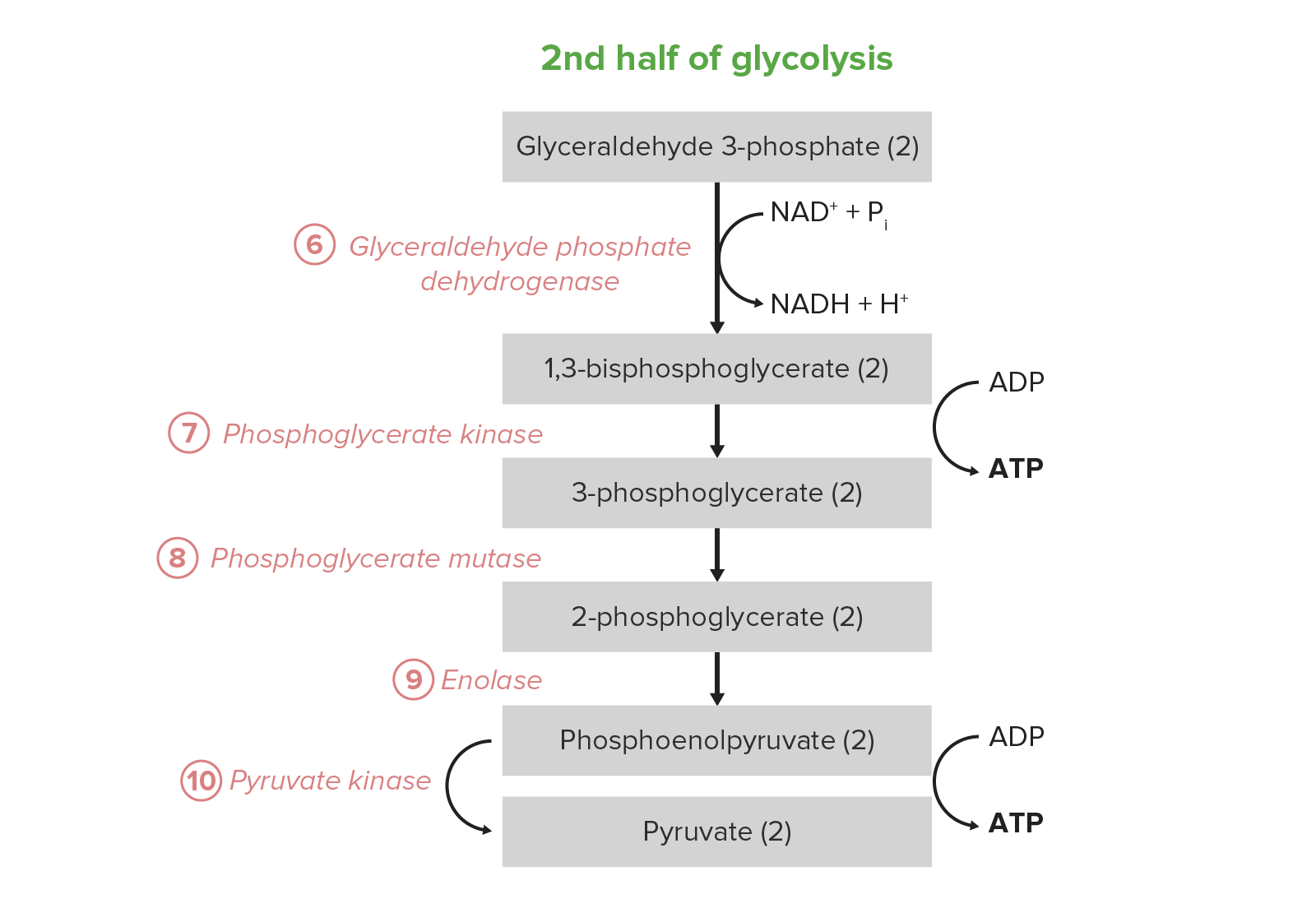Playlist
Show Playlist
Hide Playlist
Glycolysis: Glucose –> G6-P –> F6-P – Glycolysis and Pyruvate Metabolism
-
04 Advanced CarbohydrateMetabolism.pdf
-
Reference List Biochemistry.pdf
-
Download Lecture Overview
00:01 Okay so what I am going to do now is take you through step by step the individual reactions of glycolysis , discuss a little bit about the enzymes and then some additional considerations for each reaction as appropriate. 00:11 In the first reaction we see the glucose being converted into glucose-6-phosphate. 00:17 This is a very simple reaction catalyze by an enzyme called hexokinase. 00:22 You can see that this is one of reactions that requires an input of ATP in order to jump start the process. 00:29 And the reason that this happens is that the phosphorylation of glucose by itself is not energetically favorable. So the reaction is coupled to an energetically favorable reaction which is the hydrolysis of ATP to make ADP and of-course the other product being glucose-6-phosphate. 00:48 This reaction involves the carbon number 6 of a glucose as you can see here that becomes attached to the phosphate which is carbon number 6 shown in the glucose-6-phosphate. 00:58 This is a regulated step of glycolysis. 01:00 Now glycolysis has a very unusual system of regulation and there are some reasons why that's the case. 01:07 But glycolysis as we will see has three points of regulation in it and this first step is one of those point of regulation. 01:14 Hexokinase, the enzyme, is actually inhibited by it's product. 01:20 So as it's product accumulates in cells, hexokinase will quit running this reaction. 01:26 Now that's important because if a cell is, for example, making glucose what will happen is glucose-6-phosphate's concentration is increased. 01:35 And if glucose-6-phosphate concentration is increasing, then there is no reason to continue making more of it. 01:41 Hexokinase gets shut off in the process. 01:44 The delta G zero prime for this reaction is very favorable because of the hydrolysis of ATP being about -16.7 kJ/mol and it goes forward readily. 01:57 Now hexokinase is an interesting enzyme it's founds inversely all cells of the body it's not specific to glucose and that's why it's called hexokinase instead of glucokinase. 02:06 The hexo referring to 6 and the 6 that it's referring to are 6 carbon sugars. 02:13 So for example hexokinase could also work on a 6 carbon sugar like galactose and make galactose-6-phosphate. 02:20 Glucokinase which is a related enzyme has a higher Km which means that it requires a greater amount of glucose to work on and glucokinase is found in the liver. 02:32 Now that turns out to be important because glucose is made in the liver and so with glucokinase being in the liver and having a higher Km it means that glucokinase will not be active typically under the glucose concentrations where the liver is making glucose and that balance is really important. 02:50 As I said the hexokinase is inhibited by it's product and one other thing about the hexokinase is very interesting. 02:57 Hexokinase has a mechanism of action that involves what I'd like to describe as jaws. 03:02 And these jaws looks sort of like this before the enzyme has bound to it's substrate. 03:08 The two substrates that hexokinase binds to are ATP and glucose. 03:13 And in this reaction what happens is, once the enzyme has bound the ATP in my top hand and the glucose in my bottom hand We see the Koshland Induced Fit come into the play because the enzyme goes through clamping down of the jaws like I am showing here, which brings the ATP and the glucose into very close physical proximity. 03:32 This facilitates the movement of the phosphate from ATP to glucose. 03:38 At that point the jaws open and the ADP and glucose-6-phosphate are released. 03:45 In the second reaction of glycolysis this simple reaction is catalyzed by an enzyme called phosphoglucoisomerase and as it's name suggest it's catalyzing an isomerisation. 03:56 The isomerisation is simply a rearrangement of the glucose-6-phosphate into a different sugar called fructose-6-phosphate. 04:04 And though they look very different, fructose and glucose are fairly closely related to each other. 04:08 This is a readily reversible reaction. It can go forwards and it can go backwards and the direction that it proceeds will be a function of concentration of these. 04:17 Now reversible reactions are things to think about because when we go to make glucose in the process of gluconeogenesis, some of the reactions are run in the reverse reaction. This is one of those reactions.
About the Lecture
The lecture Glycolysis: Glucose –> G6-P –> F6-P – Glycolysis and Pyruvate Metabolism by Kevin Ahern, PhD is from the course Carbohydrate Metabolism.
Included Quiz Questions
Which of the following is true of hexokinase in glycolysis?
- It requires ATP to catalyze its reaction.
- It is a non-regulated enzyme of glycolysis.
- ATP and glucose-6-phosphate are two products of the reaction it catalyzes.
- It catalyzes an isomerization.
- It is the enzyme responsible for the third step in glycolysis.
Which of the following is true regarding phosphoglucoisomerase catalysis?
- The reaction is readily reversible.
- G6P is converted to F6P using energy from ATP.
- Regulators of this reaction include G6P and F2,6BP.
- The enzyme is a kinase.
- It performs a hydrolysis reaction.
Customer reviews
5,0 of 5 stars
| 5 Stars |
|
2 |
| 4 Stars |
|
0 |
| 3 Stars |
|
0 |
| 2 Stars |
|
0 |
| 1 Star |
|
0 |
Great Lecturer..well explained. Every section of lectures are meticulously explained. Clearly understood.
This lecture is amazing and I loved the explanation regarding the conformational change of hexocinase during the reaction.




